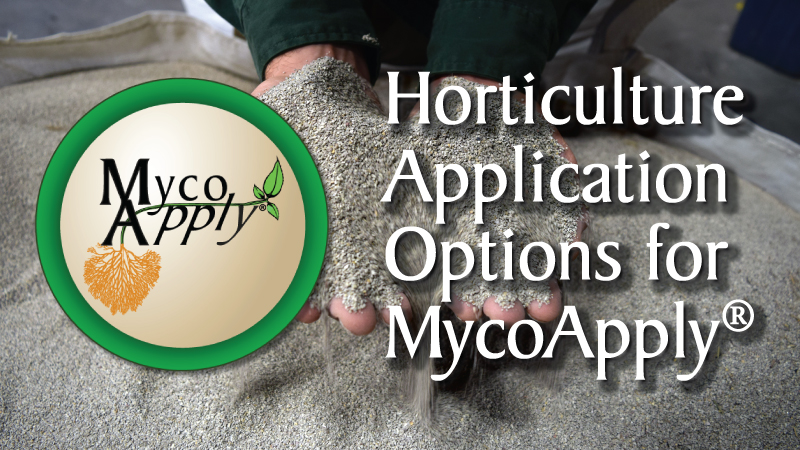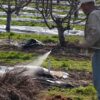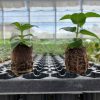
After several thousand grower visits in my career, one critical piece of information I have learned is all greenhouses and nurseries are different. For that reason, we have developed a variety of options for growers to use when incorporating mycorrhizae into their growing protocols and applying MycoApply® mycorrhizae to their plants. The application methods we recommend and are focusing on in the article below introduce mycorrhizae to the plants at the earliest stages a grower would have access to the plants. The key to success is to ensure the mycorrhizae is applied to where the actively growing roots will be growing in the future.
Tray Dip
If you purchase in plugs or rooted cuttings this is a perfect option for you. You start by thoroughly mixing up 2 oz. of either MycoApply® Ultrafine Endo or MycoApply® Ultrafine Endo/Ecto per 5 gallons (3.12 grams per liter) of water in a Sterilite® or similar type of tub that is large enough to submerge the entire root system into the suspension. Similar to other greenhouse processes, we suggest you use disposable gloves when you dip your trays. The plants should stay in the suspension for at least 10-15 seconds (long enough to allow the suspension to be completely absorbed by the soil plug). Allow excess water to drain from the tray, and then begin planting immediately. Likewise, a grower can treat the plants when they are received and hold them in the tray until the grower is ready to plant the treated plants. The tray dip of MycoApply mycorrhizae can be combined with other products to reduce labor. Just remember, the mycorrhizae need to be applied to the plant roots, not the shoots.
Bareroot Dip
If you purchase bareroot perennials, roses, small fruit plants, or trees, this is a perfect option for you. You start by thoroughly mixing up 2 oz. of either MycoApply® Ultrafine Endo or MycoApply® Ultrafine Endo/Ecto per 5 gallons (3.12 grams per liter) of water in a 5-gallon (almost 19 liter) bucket that is large enough to submerge the entire root system of the plant into the suspension. What is different about these types of plants is we suggest adding a spreader sticker to the suspension. Certain types of spreader stickers are better with this type of process and plant material. We suggest you read the labels of what you have available and make your choice. Similar to other greenhouse/nursery processes, we suggest you use disposable gloves when you dip your plants. The plants should stay in the suspension for at least 10-15 seconds (long enough to allow the suspension to totally be absorbed by the plant root system tissue). The plants can then be planted immediately. We do not suggest allowing plants to remain unplanted after treatment.
Drench
Most growers embrace this option, due to the versatility in application possibilities. Utilizing either MycoApply® Ultrafine Endo or MycoApply® Ultrafine Endo/Ecto, a grower can apply their mycorrhizae through a treatment injector (not recommended with fertilizer injectors). Here are a few tips that will help ensure success and protect valuable equipment: A grower should not scale up above the 100 gallons of drench discussed in our recommendations. We suggest you mix up your suspension, and then use some type of physical agitation to ensure the product stays in suspension throughout the application process. (Both the clay carrier and the mycorrhizae itself do not dissolve, they form a suspension when continuous agitation is applied.) It is best to try to get most of the clay through the drench system to ensure the appropriate rate or mycorrhizal propagules is applied. We recommend you remove the bottom screen of your injector, so the mycorrhizae and the clay are not hindered in their process of moving from concentrate to drench solution. It is important to remember to apply the drench to the soil and try to avoid applying it to the foliage. Some growers apply the drench before they stick their cuttings to avoid the deflection of the drench by the foliage. We recommend applying 2.7 lbs. of either of MycoApply Ultrafine Endo or Ultrafine Endo/Ecto per 1 gallon of water to create the 1 to 100 drench dilution.
Our complete drench application rate recommendations are available on our Technical Resources page: https://mycorrhizae.com/application-specification-resources/
Soil Incorporation
For large-scale growers, soil incorporation is the best choice for MycoApply application, due to ease and the reduced labor. If you are making your own growing media, all you need to do is dedicate a hopper for the MycoApply mycorrhizae. For those growers that buy a premix, if you batch mix your soil, or you have a hopper in your reconstitution/flat filling line, you can also choose soil incorporation. I find most growers that buy a premix soil do not have a hopper and then drench becomes their preferred choice of MycoApply application. If you have the ability to incorporate, you have two particulate options, granular (similar in consistency to kitty litter) or a powder (similar in consistency to lime). Your choice between the two options should focus on three topics. First, consider how confident are you that your mix line will make a homogeneous product? If you are confident in your mix line either format will work for you. If not, I suggest the granular since you put more product per yard of soil, so it is easier to get higher homogeneity. Secondly, consider what container size you will be filling with the soil you add the MycoApply to. If the cells are smaller than a 128 tray, my first choice would be to use the powder if you can. Third, the dosing ability of the hopper. The powders are more concentrated, so you need a more precise hopper to add the MycoApply.
Now you have chosen your format, all you have to decide is if you need an Endo-only mycorrhizal product or an Endo/Ecto mycorrhizal product. In general, greenhouse growers only need an Endo product. Nursery growers, depending on what they are growing, could use an Endo only or an Endo/Ecto product (click here to view a list of endo and ectomycorrhizal plants). As a reminder, Ecto mycorrhizae positively impact Conifers (you notice that I do not say evergreens, I am more specific) and hardwood trees. Endo products offered include MycoApply Endo (granular) and MycoApply Ultrafine Endo (suspendable powder). Endo/Ecto options include MycoApply Endo/Ecto (granular) and MycoApply Ultrafine Endo/Ecto (suspendable powder). The rates for all our products are included in our Soil Incorporation Recommendations, which are available on our Technical Resources page: https://mycorrhizae.com/application-specification-resources/
For now, we do not suggest using the currently available formulations of MycoApply mycorrhizae in a large-scale type fertilizer injection system or through a watering tunnel. That, however, will change as we introduce a new mycorrhizae product for this particular usage pattern this upcoming summer 2019.
Click here to view our entire line of currently available MycoApply mycorrhizal products: https://mycorrhizae.com/mycoapply-products/
If you have any questions about anything covered in this article, please contact us at 866-476-7800 or email us at inquiries@mycorrhizae.com.
Article by: Blair Busenbark
Mycorrhizal Applications – Sales & Commercial Marketing Manager
March 21, 2019






